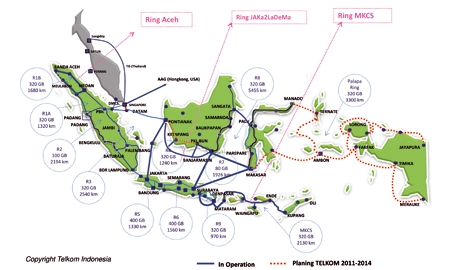The country’s flagship Nusantara Super Highway Project, known as Palapa Ring, is forming a nationwide fiber-optic network that will be the backbone of Indonesia’s information and communication technology (ICT) system. The project is expected to significantly lower the costs of telecoms and Internet access, as well as boost broadband speeds, by creating seven interconnected rings or main island groups – namely the Sumatra, Java, Kalimantan, Sulawesi, Maluku, Nusa Tenggara and Papua rings – that will strengthen inter-island and international connectivity. Covering 33 provinces and 460 districts, in total the Palapa Ring comprises 21,921 miles of undersea optical fiber and 13,489 miles of underground fiber optics.
The brainchild of the
Ministry of Communication and Information Technology (
MCIT), the Palapa Ring is on track to be fully connected by 2014 and was initially funded by telecom operators, led by Telekomunikasi Indonesia (Telkom). “Over time, the operators gradually pulled out of the project. Only one is left,” says Freddy Tulung, Director General of Information and Public Communication at MCIT. “The consortium was meant to take care of the financing. Unfortunately, they have pulled out. Now, the government is set to finance both the ICT fund and the Palapa project.”
Other ICT initiatives from the government include the Desa Berdering Program, which is establishing basic telephony services, including voice and SMS, in each of the country’s 72,000 villages. Also, the Pusat Informasi Masyarakat (PIM), or the Community Access Point (CAP), scheme aims to extend the reach of ICT within the country and involves setting up Internet community centers by 2014.
“We are now moving towards the digital era. That is why we are also preparing for the convergence of the triple C’s: communications, computers, and content. This also includes the convergence in ICT infrastructure, which covers telecommunication, Internet, and broadcasting (where we have educational entertainment),” says Mr. Tulung. “Technology infrastructure means nothing without the knowledge of the software being developed, and the impact of the regulations that are being effected. The Palapa Ring demonstrates how Indonesia is making huge strides towards strengthening its ICT infrastructure and improving the existing telecommunication systems. Combined with our highly IT-oriented youthful workforce and large market base, there are just so many opportunities for foreign investors to explore.”

0 COMMENTS